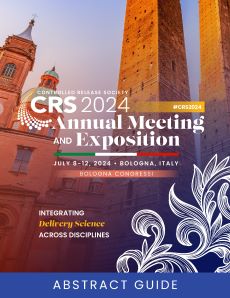Artificial Intelligence and Predictive Models in Pharmaceutical Technologies
Convergence of drug delivery with artificial intelligence, machine learning, and mathematical modeling (PK / PD modeling, compartment modeling); development of AI/ML tools for materials selection and optimization of the pharmacological and biological performance of nanomedicines and delivery systems; modeling of biophysical processes (cell uptake, mass transport, biodistribution, biodegradation etc.) to optimize the performance of drug delivery systems.
| Poster # | First Name | Last Name | Abstract Title | Abstract |
| 113 | Khair | Alhareth | Microfluidics, automation, and artificial intelligence for lipid nanoparticle design and production | View |
| 114 | Saad | Alshahrani | Leveraging Artificial Intelligence for Advancements in Pharmaceutical Research. | View |
| 115 | Ana | Melero Zaera | Computational simulations to predict the mirtazapine drug release kinetics from bentonite | View |
| 116 | Yuri | Dancik | Predicting the impact of differences in suppository formulations and in vitro dissolution methods on rectal drug pharmacokinetics using PBPK modelling | View |
| 117 | Branka | Grujić | An attempt of predicting printability of filaments using machine learning technique. | View |
| 118 | Remo | Eugster | Leveraging artificial intelligence to streamline the development of liposomal drug delivery systems | View |
| 120 | Joanne | Heade | AI-Driven Histomorphological Evaluation of Excipient Impact on Intestinal Tissue | View |
| 122 | Oleg | Igoshin | Uncovering the Interleukin-12 Pharmacokinetic Desensitization Mechanism and Its Consequences with Mathematical Modeling | View |
| 123 | Harshad | Jadhav | Accounting for colon absorption in physiologically based biopharmaceutics modeling of extended-release formulations | View |
| 124 | Harshad | Jadhav | Do physiologically relevant inputs improve drug absorption predictions in physiologically based biopharmaceutics modeling? | View |
| 126 | Robert | Kirian | Machine learning to predict extracellular vesicle properties for drug delivery applications | View |
| 129 | Thomas | Moore | MicrofluidicNP: A machine-learning platform for the microfluidic formulation development of nanomedicines | View |
| 131 | Teresa | Musumeci | Exploiting Machine learning technology to correlate mean size and zeta potential values of nanocarriers with drug targeting efficiency to the brain after intranasal administration. | View |
| 132 | Magdalini | Panagiotakopoulou | Machine Learning-Driven Approaches for Developing Targeted Lipid Nanoparticles | View |
| 133 | Daniel | Reker | Machine Learning to Predict Effectiveness of Inorganic Nanoparticles in Preclinical Cancer Research | View |
| 134 | Anne | Rodallec | PK/PD modelling to advance the preclinical development of a novel polymer prodrug in oncology | View |
| 135 | Maddalena | Sguizzato | Supramolecular delivery systems for polyphenols: prediction of in vivo diffusion and permeability | View |
| 137 | Kanika | Thakur | Demonstration of Virtual Bioequivalence (VBE) between Misoprostol Vaginal Rings Using Mechanistic Vaginal Absorption & Metabolism model (MechVAM) within Simcyp Simulator | View |
| 138 | Nadia | Toffoletto | Metformin-releasing contact lenses: predicting their in vivo efficacy using a physiology-based mathematical model | View |
| 139 | Andrew | Watson | Autoencoders to characterise and quantify variability in porcine skin | View |
| 140 | Paulina Anna | Wojtylo | MACHINE LEARNING-DRIVEN DEVELOPMENT OF INDOLE-3-ALDEHYDE DERIVATIVE THERAPEUTIC SYSTEMS | View |
| 716 | Dana | Meron Azagury | Prediction of Cancer Nanomedicines Self-Assembled from Meta-Synergistic Drug Pairs | View |
| 1231 |
Yağmur | Pirincci Tok | Drying of Canagliflozin Nanosuspension by Top Spray Granulation and Spray Drying Methods and Optimizing the Procedure | View |

